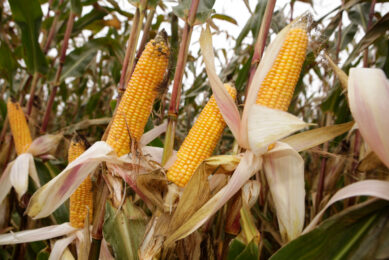The hidden risks of maize silage
New research shows dairy cows’ vulnerability to established and emerging mycotoxins and sheds light on their prevalence in feed.
Cows were long believed to be less susceptible to mycotoxins than other animals. The rumen’s ability to degrade toxins was thought to prevent them from passing into the intestine, where they can lead to decreased absorption of nutrients, “leaky gut” and a higher risk of infections.
Unfortunately, we now know that the rumen can’t fully manage the threat of mycotoxins, and certain conditions worsen the rumen’s ability to protect the cow. For example, a high dry matter intake leads to a faster passage rate, which reduces the time available for detoxifying these compounds. Additionally, if a cow is experiencing subacute ruminal acidosis (SARA), the cow will become less capable of degrading toxins, leading to a higher likelihood that they reach the intestine.
Mycotoxins in feed can harm animals and decrease production by depressing the immune system and reducing fertility, inevitably leading to farm inefficiency and economic losses. New research has shed light on just how prevalent mycotoxins are, particularly in silage, and how damaging they can be to cows’ health without proper testing and management strategies.
Biomin’s Mycotoxin Prediction Tool
“Our aim with the prediction tool is to provide an assessment of likely mycotoxin occurrence as accurate as your daily weather forecast,” explained Dr Timothy Jenkins, Development Scientist at Biomin.
Risks from silage
Silages comprise 50–70% of a dairy cow’s diet in many parts of the world and can contain a variety of mycotoxins. Ruminants are exposed to many more feedstuffs in their diet (e.g. grains, by-products, etc.) than other farm animals are.

The 2019 Biomin World Mycotoxin Survey, which analysed more than 21,000 samples in 86 countries, found that 75% of samples were contaminated with more than one mycotoxin, and co-occurring mycotoxins can have synergistic effects, making them more powerful than each mycotoxin individually.
This composition of risks for ruminants has been poorly addressed, and in practice only around half of the Dairy Global/Biomin webinar participants reported that they analyse their silage for mycotoxins.
 SARA and transition challenges webinar
SARA and transition challenges webinar
Mycotoxin Risk Management for High-Performing Cows. The role of SARA in mycotoxin and endotoxin risk management. Did you miss this webinar, it is now available to view on demand.
To better understand these risks, one study was conducted to evaluate the exposure of European dairy cows to mycotoxins through maize silage and to assess the impact of the four most relevant toxins on bovine intestinal cells. Between 2014 and 2018, 158 samples of maize silage from Europe were analysed for 61 mycotoxins. The 12 most relevant are shown in Figure 1, selected for their prevalence and known detrimental effects on cows. On average, each sample was contaminated by 13 different mycotoxins (Figure 1). Aflatoxins (AfB1), Ochratoxin A (OTA) and ergot alkaloids were less common in maize silage.
Figure 1 – Portion of contaminated maize silage samples by the twelve most relevant mycotoxins analysed from silage pits around Europe.

These results are of particular interest since aflatoxins (e.g. AfB1) are among the most feared mycotoxins by the dairy industry; however, there are many mycotoxins more commonly found in maize silage which also threaten the health of dairy cows.
Zearalenone (ZEN), deoxynivalenol (DON), nivalenol (NIV) and HT-2, which are all well-known mycotoxins from the trichothecenes family, were found in a large portion of the samples, but emerging mycotoxins, which are mycotoxins that are neither routinely measured nor legislatively regulated, were the most common mycotoxins found in this survey. The Biomin World Mycotoxin Survey also found rising incidence of emerging mycotoxins. Beauvericin and enniatins, emerging mycotoxins that can damage the immune system, were especially prevalent in Europe and the Americas. This represents an enormous challenge since very little has been done to understand the risks they pose to livestock, especially ruminants.
Under SARA, more toxins pass intact
Another recent study explored the degradation of mycotoxins in in vitro models, which simulated the capacity of an actual cow rumen to degrade the mycotoxins under normal pH (6.8) and a lower pH (5.8), simulating acidosis. For DON and NIV, the microbial degradation was slower when pH was decreased; a delay in degradation is of concern when the passage rate is accelerated due to high feed intake, allowing some mycotoxins to reach the intestine intact. For enniatin B (ENNB) on the other hand, degradation was weak under both conditions. With a normal pH, the maximum degradation achieved was 75%, and a lower pH worsens it by degrading only a maximum of 20% of the initial concentration.
 Managing mycotoxins – special publication
Managing mycotoxins – special publication
Mitigating mycotoxins is a huge global challenge with no universal solution. Developments need to happen from all sides of the supply chain. Here, the latest breakthroughs across these areas are explored.
Mycotoxins’ effects on the intestines
In addition to looking at the prevalence of mycotoxins and how they are degraded in real-world conditions, for the first time an in vitro model using calf intestinal epithelial cells (CIEB) was used to determine the toxic effects on the intestines of Fusarium toxins (DON, NIV and fumonisin [FB1]) and enniatin B (ENNB) – selected for their relevance for dairy cows since they were highly prevalent in silage samples – on the intestines (Figure 2).
Figure 2 – Cytotoxicity of fumonisin b1, nivalenol, deoxinivalenol and enniatin b1 over calf intestinal epithelial cells through the WST-1 assay.

All mycotoxins caused cells to die or deactivate, increasing the possibility that mycotoxins or other harmful substances like gram negative bacteria could reach the bloodstream and cause systemic infections. NIV and DON had the greatest detrimental effects. Even at concentrations of 138 ppb NIV and 172 ppb DON, the cell viability was reduced by 25%. Furthermore, the ENNB and FB1 led to the same 25% reduction at 1,500 ppb and 3,383 ppb, respectively. For NIV and DON, the numbers align with trials on pig and human intestinal cells. Although it is not always easy to translate in vitro results to in vivo results, the fact is that intestinal cells of ruminants are as sensitive as those of pigs and humans, according to the author.
![]() Mycotoxins Knowledge Centre
Mycotoxins Knowledge Centre
This interactive tool provides information on the impact on livestock health, A-Z of mycotoxins, plus the regulations for mycotoxins per commodity per country.
3 tips to mitigate risks of mycotoxins
Taken together, these studies clearly indicate risks for dairy farmers. Mycotoxin degradation is incomplete even in ideal conditions and is significantly compromised during high feed intake and acidosis. Given the prevalence of mycotoxins in maize silage, failing to implement a mycotoxin risk management strategy for ruminants could result in losses in production and, subsequently, profit. Follow these 3 tips to ensure mycotoxins do not compromise the health of your herd.
- Test early and often. It’s important to understand the mycotoxin load in your silage feeds because of the number and diversity of mycotoxins it may contain. Sampling and analysing silage and feed for mycotoxins is essential for creating the right detoxification strategy.
- Bind and deactivate. After analysis, nutritionists, technicians and farmers need to consider the load of mycotoxins coming from the feed and establish the level of risk. Once this is done, the right combination of binders and deactivators can be determined and added to feed.
- Support. Support bovine gut health with the right mix of probiotics and phytogenic feed additives to improve nutrient absorption and immunity.
Join 13,000+ subscribers
Subscribe to our newsletter to stay updated about all the need-to-know content in the dairy sector, two times a week.










